The Quad cursor menu
 The Intelligent Quad Cursor
The Intelligent Quad Cursor
 Customize the Quad to your workspace
Customize the Quad to your workspace
 Placing Associative
Dimensions Using the Quad
Placing Associative
Dimensions Using the Quad
 How
to edit poly lines with the Quad
How
to edit poly lines with the Quad
The Quad cursor menu, aka the Quad is an alternative to
grip-editing of entities, offering a (much) richer set of editing
operations while requiring fewer clicks, without cluttering the
screen with loads of grip-glyphs.
While the Quad was initially conceived for easy and fast editing
of 3D solids, the Quad is extended to allow enhanced editing of all
entity types.
If the Display the Quad on right
click flag of the QUADDISPLAY
system variable is set, all commands that exist in the No Selection command group in the Quad can be
launched. Edit the No Selection
command group to customize the available commands (see To edit the workspace command
groups).
To activate the
Quad
Activation of the Quad is controlled by the QUADDISPLAY
system variable.
To toggle the Quad On/Off, do one of the following:
- Click the
QUAD field in the
Status bar.
- Press the F12
function key.
- Edit the QUADDISPLAY system variable in the Settings
dialog.
- Type quaddisplay in the command bar, then choose an
option.
Editing the Quad
settings
- Right click the QUAD
field in the
Status bar, then choose Settings
in the context menu.
The Settings dialog
opens, showing the Quad settings:
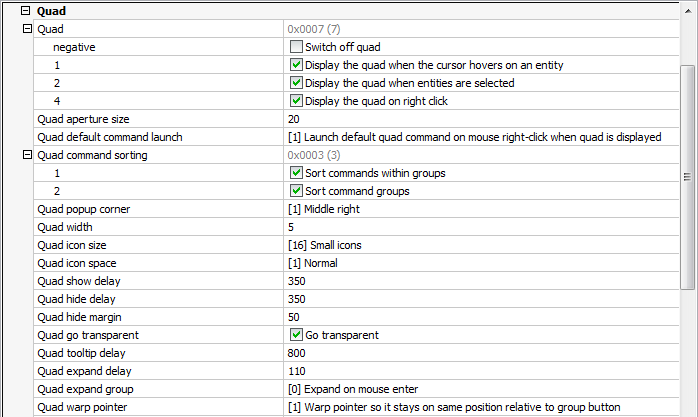
- Quad Display:
Determines when the Quad displays.
-
- 1: When the cursor is over an entity.
The entity under the cursor highlights.
- 2: When entities are selected
- 4: On right click when no entities are
selected and there is no entity under the cursor.
- Quad aperture
size: Distance in pixels to search for neighboring
entities.
- Quad default command
launch: Sets the action to launch the default Quad
command.
-
- 0: Click the button.
- 1: Right click
- Quad command
sorting:
-
- 1: Sort
commands within groups: most recently used command
first.
- 2: Sort
command groups: morst recently used group on top.
- Quad: Controls
the Quad display.
- Quad Width:
Defines the number of commands in a row. Default = 4 commands.
-
Quad icon size:
Small icons (16 x 16 pixels) or Large icons (32 x 32 pixels)
|

|

|
|
Small
Icons
|
Large
Icons
|
-
Quad icon
space: Defines the size of the Quad tool buttons: small,
normal or large.
- Quad show
delay: Sets the time lap in milliseconds between the
highlighting of the entity and the Quad display.
- Quad hide
delay: Sets the time lap in milliseconds to hide the Quad
when the cursor is outside the Quad hide
margin limit.
- Quad hide
margin: Sets the distance in pixels the cursor can move away
from the Quad. If the cursor moves outside this limit, the Quad is
hidden.
- Quad go
transparent: Defines whether the Quad becomes transparent
when the mouse moves outside the Quad, but within the Quad hide margin.
- Quad tooltip
delay: Sets the delay time in milliseconds to display
tooltips. If the value is negative, no tooltips display.
- Quad expand
group: Defines when a Quad command group is expanded: on
mouse enter or on mouse click.
- Quad warp
pointer: Defines what to do to keep the position of the
pointer and the cursor in sync when a command group expands or
collapses: move the Quad or move the pointer.
- To edit a setting, select the setting then do one
of the following:
- Type a new value.
- Click the check box.
- Choose an option.
- Close the Settings
dialog.
The Quad layout
The layout of the Quad cursor menu depends on:
- The entity type under de cursor.
- The current
Workspace.
- Geometric events such as intersection or
tangency.
In general the Quad has three appearances: last command, command
history and full.
- When the cursor hovers over an entity, the
entity highlights and the Quad displays the command most recently
used with this entity type.

Right click to launch the command.
- Move the cursor to the Quad, to display the
most recently used commands with this entity type.
The number of commands is controlled by the QuadWidth user preference.

Click an icon to launch the command.
- Move the cursor over the blue field below
the icons to expand the Quad cursor menu.
The first command group expands.
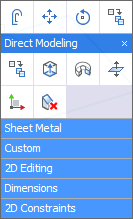
Click an icon to launch a command.
Depending on the current value of the QuadExpandGroup user preference either click
another command group or move the cursor to another command
group.

- (option) Click the Close icon (
 ) of a command group to hide this command group in the
Quad for the current workspace.
) of a command group to hide this command group in the
Quad for the current workspace.
Click the OK button on the
Confirm dialog box to hide the
command group.
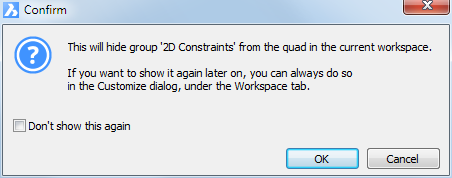
See To
edit the workspace command groups to switch closed command
groups on.
Using the Quad
- Move the cursor to the entity you want to
manipulate.
The entity highlights and the Quad cursor displays the most
recently used command with this entity type.
- (option) Select more entities.
See Selecting multiple
entities.
- Do one of the following:
- Depending on the value of the QUADCOMMANDLAUNCH
system variable, either right click or click the Quad to repeat the
most recently used command.
- Move the cursor to the Quad and select a
different command.
See The Quad Layout.
- Execute the command.
Selecting multiple
entities
- Move the cursor over the first entity, then click
when the entity highlights.
The entity is selected and remains highlighted.
- Move the cursor to another entity, then click when
the entity hightlights.
The entity is added to the selection set and remains
highlighted.
- (option) Repeat step 2 to select more
entities.
- (option) Move the cursor to a selected entity,
then press and hold the Shift key and click.
The entity is removed from the selection set.
|
NOTES
|
-
When the Quad is active,
SELECTIONPREVIEW is neglected, unless a command prompts for
entity selection.
-
When working with solids:
-
The
SELECTIONMODES system variable controls which subentities are
detected: edges, faces and/or boundaries.
-
Click a button on the Selection
Modes toolbar to toggle an option. A pressed button
indicates the option is selected.

 Enable detection of 3D solid
edges Enable detection of 3D solid
edges
 Enable detection of 3D solid
faces Enable detection of 3D solid
faces
 Enable boundary detection Enable boundary detection
|
Selecting edges of
faces or solids
Command: DmSelectEdges
- Select the faces and or solids.
See Selecting multiple
entities.
- In the Direct
Modeling command group of the Quad cursor menu, click the
Select Edges tool (
 ).
).
All edges of the selected faces and solids are selected.
- (option) To remove edges from the selection set:
press and hold the Shift key, then click the edge(s).
Customizing the
Quad
The number of available command groups in the Quad is defined
through the current workspace.
Only the content of the Custom
command group can be modified. The content of the other command
groups is hard-coded and cannot be modified.
To edit the workspace command
groups
- Move the cursor over a toolbar, then right click
and choose Customize in the context
menu.
- Click the Workspace
tab on the Customize dialog box.
- Expand the workspace you want to edit.
- Expand the Quad Group
Order list.
Command groups that are currently switched off display in
grey.

- To edit visibility state of a command group, right
click a command group then choose Switch
On or Switch Off in the
context menu.
To edit the Custom command
group
- Move the cursor over a toolbar, then right click
and choose Customize in the context
menu.
- Click the Quad tab
on the Customize dialog box.
- Expand the Custom
command group.
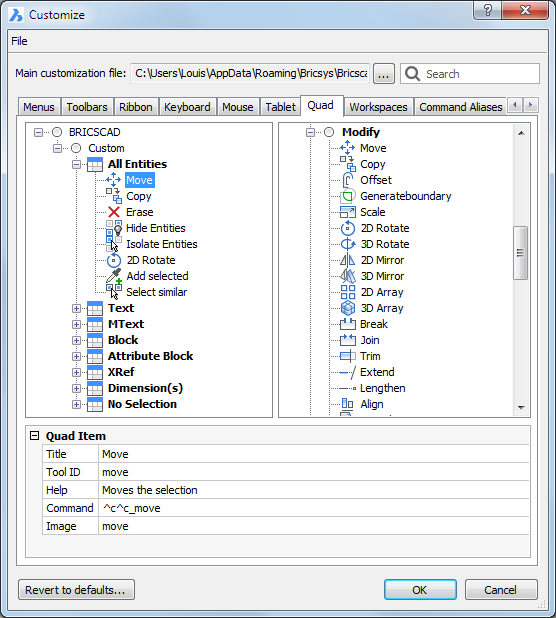
- (option) Add a Quad Item Group:
- Do one of the following:
-
- Right click the Custom command group name, then choose
Append quad item group in the context
menu to add a new group at the bottom of the list.
- Right click a group item name then choose
Append quad item group in the context
menu to add a new group above the selected item group.
The Add Quad Item
Group dialog box displays.
- Type a name in the Group name field.
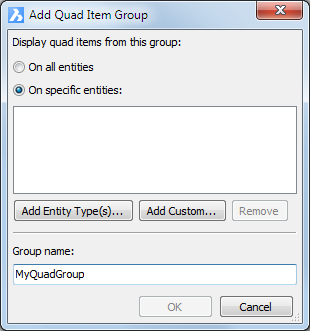
- Do one of the following:
-
- Select On all
entities to apply the new group to all entity types, and
click the OK button to create the new
item group.
- Select On Specific
entities to apply the new group to one or more specific
entity types, and proceed with the next step.
- Click the Entity
Type(s)... button and select one or more entity types.
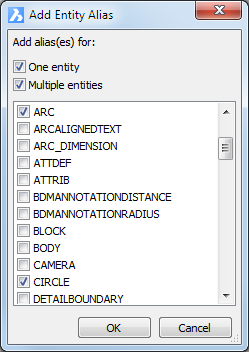
- Check either One entity or Multiple entities
or both.
- Check one or more entity types in the
list.
- Click the OK
button.
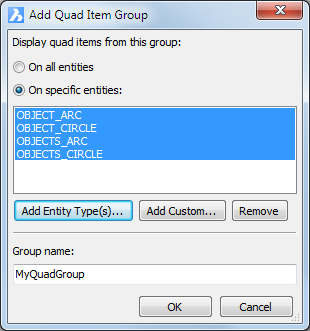
- Click the OK
button to create the new item group.
- (option) Add a command to an item group:
Select a tool in the right hand pane of the Customize dialog box, then drag the tool to the
item group.
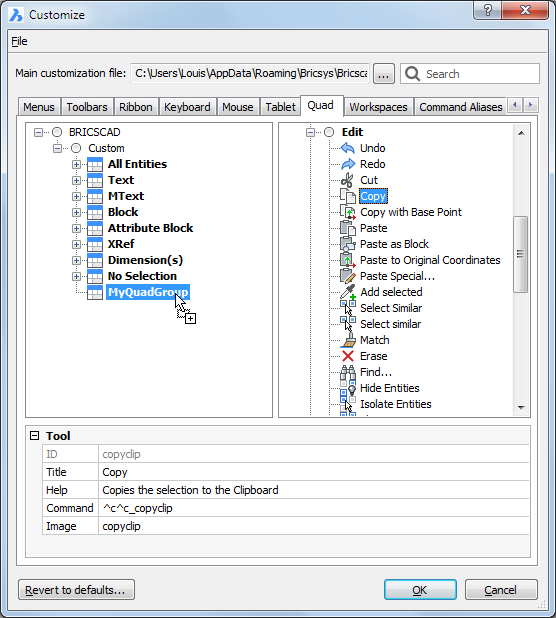
- Click the OK button
on the Customize dialog to save the
changes.
|
© Menhirs NV. All rights reserved. |
![]() Customize the Quad to your workspace
Customize the Quad to your workspace![]()
![]() Placing Associative
Dimensions Using the Quad
Placing Associative
Dimensions Using the Quad![]()
![]() How
to edit poly lines with the Quad
How
to edit poly lines with the Quad![]()

![]()
![]()








